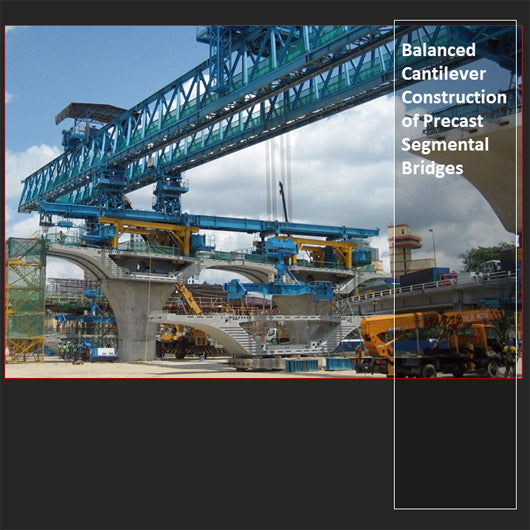
Balanced Cantilever Construction of Precast Segmental Bridges
81 pages
Regular price
$ 65.00
Sale
Balanced cantilever construction is a rapid, cost-effective construction method for precast segmental bridges. When the deck can be reached from the ground and the segments can be delivered at the base of the piers, ground and floating cranes usually provide the most efficient erection procedures with minimal temporary works. Balanced cantilever bridges, however, are selected in response to inaccessible terrains, and the deck is often erected with lifting frames and self-launching gantries.
In 81 pages, the eManual provides exhaustive coverage of balanced cantilever construction of precast segmental bridges. It explores the load and stiffness interactions to consider for the design of piers and superstructures, the stability of tall bridge piers under the loads applied by self-launching gantries, the midspan closure operations, different decking solutions for cable-stayed bridges, and different types of expansion joints. It also explores loads, kinematics, performance, productivity and structure-equipment interactions of the self-launching gantries for balanced cantilever construction and the different families of lifting frames.
- Introduction
- Lifting frames
- Loading, kinematic, typical features
- Support, launch and lock systems
- Performance and productivity
- Structure-equipment interaction
- Self-launching gantries
- Loading, kinematic, typical features
- Support, launch and lock systems
- Performance and productivity
- Structure-equipment interaction
- References
The eManual is a milestone of the Bridge Engineering eManuals Project. Combined with Short Line Match Casting of Precast Segmental Bridges (42 pages), the two monographs cover the entire construction process of precast segmental bridges. They explain how balanced cantilever construction influences bridge design and segment fabrication, and explore bridge design for modularity and the factors that drive the choice between precast segmental technology and in-place casting with form travelers. They explain the short-line method, the operations of casting cells for constant- and varying-depth segments, and the geometric design of the deck for standardized production of atypical segments and geometry correction with the typical segments. They also explain how to generate the casting curve in relation to precasting sequence, erection sequence and time-dependent effects, the geometry control of short-line casting (inclusive of commercial software programs and how they work) and the progressive correction of geometry errors. They also explore the long-line method, post-casting operations, different organizations of the stockyard, and segment delivery and epoxy gluing at the erection site.
Combined with the collection Span-by-Span Construction of Precast Segmental Bridges (134 pages), the monographs provide 215 pages of exhaustive coverage of all the construction methods and all the types of specialized construction equipment for precast segmental bridges. If you are interested in the design, construction and inspection of precast segmental bridges, either combination will provide you with a unique wealth of knowledge, learning and insights on this construction method.
Last but not least, the eManual Construction Cost of Precast Segmental Bridges (134 pages) and the companion estimation spreadsheet explore the construction cost of precast segmental decks. The segment fabrication costs include the setup costs of precasting facilities and the production costs of the short- and long-line method. Segment transportation includes trucking, trains and barges, with or without intermediate staging areas. Segment erection includes span-by-span and balanced cantilever construction and the setup and production costs of the different types of special equipment. The estimation spreadsheet includes 1004 cost items (yes, you have read well: one thousand and four) and three columns for each cost item: construction costs, opportunities (potential of cost savings), and risks (potential of extra costs).
When combined, the monographs of the Bridge Engineering eManuals Project provide 349 pages of exhaustive coverage of all the construction methods and all the types of special construction equipment for precast segmental bridges. If you thought that ASBI Construction Practices Handbook for Concrete Segmental and Cable-Supported Bridges was the international reference for the design and construction of precast segmental bridges, you will be greatly surprised.
